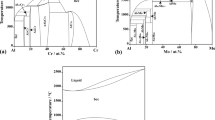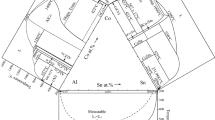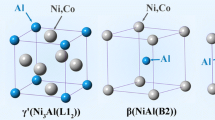Abstract
The Al–Ca–Ni ternary system has been experimentally investigated and thermodynamically assessed to contribute to the development of a novel Al-base amorphous alloy. A new approach in alloy preparation was used due to the special properties of calcium. With selected equilibrated alloys, the isothermal sections of the Al–Ca–Ni system at 873 and 673 K were obtained by means of scanning electron microscopy, electron probe micro-analysis (EPMA) and powder X-ray diffractometry (XRD). Phase transformation temperatures were measured by differential scanning calorimetry (DSC) analysis. The liquidus projection of this ternary system was determined by identification of primary crystallization phases in as-cast samples and from the liquidus temperatures obtained from DSC analysis. A new ternary compound Al78Ca9Ni13 (referred to as τ 3 here after) has been confirmed to exist in both the 873 and 673 K isothermal sections on the basis of EPMA and XRD analysis. All sample compositions are Al-rich: A1–A4 samples > 72.64 at.% Al, B1–B10, C1–C11 > 45 at.% Al, with only C12 at 36.8 at.% Al. Based on the available data of the binary systems Al–Ni, Al–Ca, Ca–Ni and the ternary system Al–Ca–Ni from the literature and present work, thermodynamic modelling of the Al–Ca–Ni ternary system was performed using the calculation of phase diagram method coupled with first-principle calculations. A set of consistent thermodynamic parameters for the Al–Ca–Ni ternary system was obtained with good agreement with the experimental results in the Al-rich region. The calculated data in the Al-poor region are a very plausible prediction, but not validated.













Similar content being viewed by others
References
Inoue A, Shen B, Koshiba H, Kato H, Yavari AR (2003) Cobalt-based bulk glassy alloy with ultra-high strength and soft magnetic properties. Nat Mater 2:661–663
Schroers J, Johnson WL (2004) Ductile bulk metallic glass. Phys Rev Lett 93:255506
Zhang B, Pan MX, Zhao DQ, Wang WH (2004) “Soft” bulk metallic glasses based on cerium. Appl Phys Lett 85:61–63
Liu YH, Wang G, Wang RJ, Zhao DQ, Pan MX, Wang WH (2007) Super plastic bulk metallic glasses at room temperature. Science 315:1385–1388
Lindsay Greer A (2015) New horizons for glass formation and stability. Nat Mater 14:542–546
Guo S, Liu Y (2012) Estimation of critical cooling rates for formation of amorphous alloys from critical sizes. J Noncryst Solids 358:2753–2758
Ge L, Hui X, Wang ER, Chen GL, Arroyave R, Liu ZK (2008) Prediction of the glass forming ability in Cu–Zr binary and Cu–Zr–Ti ternary alloys. Intermetallics 16:27–33
Wang JQ, Liu YH, Imhoff S, Chen N, Louzguine-Luzgin DV, Takeuchi A, Chen MW, Kato H, Perepezko JH, Inoue A (2012) Enhance the thermal stability and glass forming ability of Al-based metallic glass by Ca minor-alloying. Intermetallics 29:35–40
Ayers JD, Jones HN, Vold CL (1993) Stabilization of aluminum and magnesium base metallic glasses by the addition of calcium. Scr Metall Mater 29:205–209
Han FF, Inoue A, Han Y, Kong FL, Zhu SL, Shalaan E, Al-Marzouki F (2016) High formability of glass plus fcc-Al phases in rapidly solidified Al-based multicomponent alloy. J Mater Sci 52:1246–1254. doi:10.1007/s10853-016-0394-6
Jiang YR, Li X, Jiang Y, Huang SH, Shi X, Mao C, Zhang LG, Liu LB, Zheng F (2017) Experimental investigation of phase relations in Al–Co–Y ternary system. Calphad 56:1–9
Li X, Liu LB, Jiang Y, Huang GX, Wang X, Jiang YR, Liang JS, Zhang LG, Shi X (2016) Thermodynamic evaluation of the phase equilibria and glass-forming ability of the Al–Co–Gd system. Calphad 52:57–65
Bao XH, Liu LB, Jiang YR, Jiang Y, Mao C, Li X, Zhang LG (2016) Thermodynamic assessment of the Al–Ba system. J Phase Equilib Diffus 37:345–349
Huang SX, Zhang XD, Jiang Y, Jiang YR, Mao C, Wu D, Liu LB, Zhang LG (2017) Experimental investigation of Ti–Nb–Co at 1000°C. Mater Des 115:170–178
Bo H, Liu LB, Hu JL, Jin ZP (2015) Experimental investigation and thermodynamic modeling of the Al–Dy–Zr system. J Mater Sci 50:6427–6436. doi:10.1007/s10853-015-9197-4
Bai WM, Jiang Y, Guo ZY, Zeng LJ, Tan MY, Meggs C, Zhang LG, Liu LB, Jin ZP (2017) Experimental and thermodynamic investigation of Al–Cu–Nd ternary system. Mater Chem Phys 195:94–104
Kaufman L, Bernstein H (1970) Computer calculation of phase diagrams with special reference to refractory metals. Academic Press, New York
Alexander WO, Vaughan NB (1937) Investigation of phase equilibria in Al–Ni system. J Inst Met 61:247–260
Nash P, Singleton MF, Murray JL (1991) In: Nash P (ed) Phase diagrams of binary nickel alloys. ASM International, Materials Park, pp 3–11
Okamoto H (1993) Phase diagram updates: section III: Al–Ni. J Phase Equilib 14:257–259
Kaufman L, Nesor H (1978) Coupled phase diagrams and thermochemical data for transition metal binary systems—V. Calphad 2:325–348
Du Y, Clavaguera N (1996) Thermodynamic assessment of the A1–Ni system. J Alloys Compd 237:20–32
Ansara I, Dupin N, Lukas HL, Sundman B (1997) Thermodynamic assessment of the A1–Ni system. J Alloys Compd 247:20–30
Andersson JO, Guillermet AF, Hillert M, Jansson B, Sundman B (1986) A compound-energy model of ordering in a phase with sites of different coordination numbers. Acta Metall 34:437–445
Huang W, Chang YA (1998) A thermodynamic analysis of the Ni–Al system. Intermetallics 6:487–498
Dupin N, Ansara I, Sundman B (2001) Thermodynamic re-assessment of the ternary system Al–Cr–Ni. Calphad 25:279–298
Zhang F, Chang YA, Du Y, Chen SL, Oates WA (2003) Application of the cluster-site approximation (CSA) model to the Fcc phase in the Ni–Al system. Acta Mater 51:207–216
Chen HL, Doernberg E, Svoboda P, Schmid-Fetzer R (2011) Thermodynamics of the Al3Ni phase and revision of the Al–Ni system. Thermochim Acta 512:189–195
Wang Y, Cacciamani G (2016) Thermodynamic modeling of the Al–Cr–Ni system over the entire composition and temperature range. J Alloys Compd 688:422–435
Hansen M, Anderko K (1958) Constitution of binary alloys, 2nd edn. McGraw-Hill, New York
Huang B, Corbett JD (1998) Two new binary calcium–aluminum compounds: Ca13Al14, with a novel two-dimensional aluminum network, and Ca8Al3, an Fe3Al-type analogue1. Inorg Chem 37:5827–5833
Kevorkov D, Schmid-Fetzer R (2001) The Al–Ca system, Part 1: experimental investigation of phase equilibria and crystal structures. Z. Metall 92:946–952
Ozturk K, Chen LQ, Liu ZK (2002) Thermodynamic assessment of the Al–Ca binary system using random solution and associate models. J Alloys Compd 340:199–206
Wolverton C, Yan XY, Vijayaraghavan R, Ozolins V (2002) Incorporating first-principles energetics in computational thermodynamics approaches. Acta Mater 50:2187–2197
Ozturk K, Zhong Y, Chen LQ, Liu ZK, Sofo JO, Wolverton C (2005) Linking first-principles energetics to CALPHAD: an application to thermodynamic modeling of the Al–Ca binary system. Metall Mater Trans A 36:5–13
Takeuchi Y, Mochizuki K, Watanabe M, Obinata I (1966) The alloys of nickel with alkaline earth metals. Metallurgy 20:2–8
Buschow KHJ (1974) Calcium–nickel intermetallic compounds. J Less Common Metals 38:95–98
Saindrenan G, Vitart-Barbier J, Constantinoff M (1986) Structural study of nickel–calcium alloys containing between 0 and 15 wt% calcium. J Less Common Metals 118:227–333
Notin M, Belbacha D, Rahmane M, Hertz J, Saindrenan G, Jorda JL (1990) Experimental diagram and numerical optimization of the Ca–Ni system. J Less Common Metals 162:221–229
Uremovich D, Islam F, Medraj M (2006) Thermodynamic modelling of the Ca–Ni system. Sci Technol Adv Mat 7:119–126
Shinoda G (1928) Use of X-ray analysis to study the improvement of Al alloys (in Japanese). Nippon Kogvo Kwai Shi 44:544–562
Manyako NB, Zarechnyuk OS, Yanson TI (1987) Crystal structure of CaNiAl9. Sov Phys Crystallogr 32:816–817
Manyako NB, Yanson TI, Zarechnyuk OS (1988) Phase equilibria in the Ca–Co(Ni)–Al systems at 770 K. Izv Akad Nauk SSSR Met 3:185–187
Massalski TB (ed) (1990) Binary alloy phase diagrams, 2nd edn. ASM International, Metals Park
Villars P, Calvert LD (1991) Pearson’s handbook of crystallographic data for intermetallic phases, 2nd edn. ASM, Materials Park
Viklund P, Haeussermann U, Lidin S (1996) NiAl3: a structure type of its own? Acta Crystallogr A Found Crystallogr A 52:C321
Gavra Z, Akiba E, Murray J, Calvert LD, Taylor JB (1985) Isotherms and crystallography of the hydrides of the system Ca x Eu1−x Ni5. Mater Res Bull 20:209–215
Oesterreicher H, Ensslen K, Kerlin A, Bucher E (1980) Hydriding behavior in Ca–Mg–Ni–B. Mater Res Bull 15:275–283
Dinsdale AT (1991) SGTE data for pure elements. Calphad 15:317–425
Redlich O, Kister AT (1948) Algebraic representation of thermodynamic properties and the classification of solutions. Ind Eng Chem 40:345–348
Blöchl PE (1994) Projector augmented-wave method. Phys Rev B 50:17953–17979
Kresse G, Joubert D (1999) From ultrasoft pseudopotentials to the projector augmented-wave method. Phys Rev B 59:1758–1775
Kresse G, Furthmüller J (1996) Efficient iterative schemes for ab initio total-energy calculations using a plane-wave basis set. Phys Rev B 54:11169–11186
Kresse G, Furthmüller J (1996) Efficiency of ab initio total energy calculations for metals and semiconductors using a plane-wave basis set. Comput Mater Sci 6:15–50
Perdew JP, Burke K, Ernzerhof M (1996) Generalized gradient approximation made simple. Phys Rev Lett 77:3865–3870
Perdew JP, Burke K, Ernzerhof M (1997) Emission in symmetric heavy ion reactions at subthreshold energies. Phys Rev Lett 78:1396
Monkhorst HJ, Pack JD (1976) Special points for Brillouin-zone integrations. Phys Rev B 13:5188–5192
Methfessel M, Paxton AT (1989) High-precision sampling for Brillouin-zone integration in metals. Phys Rev B 40:3616–3621
Sundman B, Jansson B, Andersson JO (1985) The thermo-calc databank system. Calphad 9:153–190
Chen SL, Daniel S, Zhang F, Chang YA, Yan XY, Xie FY, Schmid-Fetzer R, Oates WA (2002) The PANDAT software package and its applications. Calphad 26:175–188
Acknowledgements
The authors would like to express gratitude to the financial support of the National Key Technologies Research and Development Program of China (Grant No. 2016YFB0701301) and the National Natural Science Foundation of China (Grant Nos. 51371200, 51671218 and 51501229). The authors also would like to give thanks to Mr. Carl Meggs (University of Birmingham) for the English improvement.
Author information
Authors and Affiliations
Corresponding authors
Ethics declarations
Conflict of interest
The authors declare that they have no conflict of interest.
Electronic supplementary material
Below is the link to the electronic supplementary material.
Rights and permissions
About this article
Cite this article
Jiang, Y., Shi, X., Bao, X. et al. Experimental investigation and thermodynamic assessment of Al–Ca–Ni ternary system. J Mater Sci 52, 12409–12426 (2017). https://doi.org/10.1007/s10853-017-1338-5
Received:
Accepted:
Published:
Issue Date:
DOI: https://doi.org/10.1007/s10853-017-1338-5




